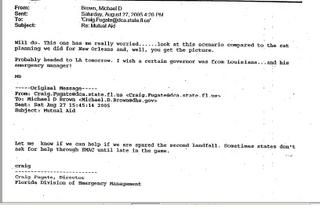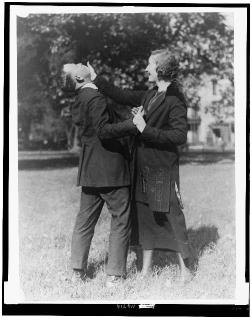
Wednesday, October 26, 2005
Tuesday, October 25, 2005
If only we could go Back to the Future

Poll: Bush would lose an election if held this year
A majority would vote for a Democrat over President Bush if an election were held this year, according to a CNN/USA Today/Gallup Poll released Tuesday.
In the latest poll, 55 percent of the respondents said that they would vote for the Democratic candidate if Bush were again running for the presidency this year.
the rest of the article is @ http://www.cnn.com/2005/POLITICS/10/25/poll.bush/index.html
Photo was googled from http://bushspeaks.com
Dx 4 the USA
Diagnosis For America
Jonathan Tasini
October 25, 2005
Jonathan Tasini is president of the Economic Future Group and writes his "Working In America" columns for TomPaine.com on an occasional basis. His blog Working Life chronicles the labor movement and other issues affecting American workers.
It is a measure of our lowered expectations, fueled by media spin, that people shrugged and seemed to think that it was inevitable that workers for General Motors were destined to have their health care coverage slashed. After all, some seemed to think, at a time when their company is teetering on the edge of oblivion, these “privileged” auto workers had “gold-plated” coverage that almost no other workers in America have.
But let’s be clear: The loss of benefits for GM workers was not inevitable. It happened as a result of many years of bipartisan political and economic decisions and the bipartisan lack of political courage to take on dumb ideology and corporate power.
In the minds of the elites, socking workers with a larger share of the costs of health care is just a natural part of the new economic order. As the Wall Street Journal editorial board said about the health care cost-cutting deal between GM and the United Auto Workers, “We hope it’s the beginning of wisdom about the global economy for the American labor movement.” Speaking about UAW president Ron Gettelfinger, Delphi CEO Steve Miller—who took his company into bankruptcy—said, “He’s going to have to help half a million of workers get used to the idea that globalization has taken away the ability to have someone who mows the lawn or sweeps the floor get $65 an hour.”
At least one thing is refreshing: It exposes as a fraud the liberal and conservative mantra about the wonders of the global economy. Democrats and Republicans alike—from Bill Clinton to George Bush, with a supporting cast of media and academic geniuses—have repeatedly told workers that the global economy will bring great benefits to America, after a period of “adjustment.” To their credit, Steve Miller and the Journal are more honest: The global economy is a tool to drive down living standards, starting with health care. Get with it, folks: Living large is so “old economy.”
So, the first obvious point to make is that employer-provided health care coverage has failed. Workers should never face the choice between sickness and financial ruin simply because the company they work for is going under, poorly managed or because they change jobs. More important, this has become, as I pointed out some months ago, a matter of economic competitiveness for corporations based in the United States: The health care system is dragging down profits.
The second point, then, is that health insurance can never be left to those whose sole motivation is profit. The last time health care was debated, the Clinton administration lost its nerve—or, perhaps, never had any other intention to pursue a system other than one that was destined to perpetuate the existing ideological flaws. “Hillarycare” was a disaster for the public not because the mismanaged process produced an overly complex system. Rather, the Clintons made a conscious decision to leave health care in the hands of the private insurers—which allowed the HMO industry to grow, if you’ll pardon the expression, like a malignant tumor.
If we had a different philosophy, GM workers’ health care would never change. As Ida Hellander, executive director of Physicians for a National Health Program (PNHP), puts it, “Political will is infinitely harder to muster, especially when Congress is owned by the drug and insurance companies.”
PNHP has a very straightforward set of four principles guiding its universal health care proposal, which I think, if properly understood by the public, would send millions of people to the streets demanding immediate change:
1. Access to comprehensive health care is a human right. It is the responsibility of society, through its government, to assure this right. Coverage should not be tied to employment. Private insurance firms’ past record disqualifies them from a central role in managing health care.
2. The right to choose and change one’s physician is fundamental to patient autonomy. Patients should be free to seek care from any licensed health care professional.
3. Pursuit of corporate profit and personal fortune have no place in caregiving and they create enormous waste. The U.S. already spends enough to provide comprehensive health care to all Americans with no increase in total costs. However, the vast health care resources now squandered on bureaucracy (mostly due to efforts to divert costs to other payers or onto patients themselves), profits, marketing and useless or even harmful medical interventions must be shifted to needed care.
4. In a democracy, the public should set overall health policies. Personal medical decisions must be made by patients with their caregivers, not by corporate or government bureaucrats.
The economics of a single-payer, universal health care system are unassailable. It would save $300 billion in administration costs. It would be financed partly by the 60 percent of taxes that already go into the health care system via Medicaid, Medicare and payments for public employee coverage. The rest of the financing, over the long term, would be easily done with modest tax increases (by a 7 percent payroll tax and a 2 percent progressive income tax) —and result in better health care for people for less money than people shell out in ever-rising deductibles. With one bold stroke, a single-payer system would do more to help the bottom line of companies than any tax break or so-called “free trade” agreement.
The troubling reality to the arguments I’ve made is that they are not particularly original: The moral and economic need for a universal health care system has been well-known for a very long time. The only question now is: How many companies will have to go belly up and how many more millions of workers will face bankruptcy and illness because we allow ideology—the deification of the so-called free market—to triumph over common sense?
Jonathan Tasini
October 25, 2005
Jonathan Tasini is president of the Economic Future Group and writes his "Working In America" columns for TomPaine.com on an occasional basis. His blog Working Life chronicles the labor movement and other issues affecting American workers.
It is a measure of our lowered expectations, fueled by media spin, that people shrugged and seemed to think that it was inevitable that workers for General Motors were destined to have their health care coverage slashed. After all, some seemed to think, at a time when their company is teetering on the edge of oblivion, these “privileged” auto workers had “gold-plated” coverage that almost no other workers in America have.
But let’s be clear: The loss of benefits for GM workers was not inevitable. It happened as a result of many years of bipartisan political and economic decisions and the bipartisan lack of political courage to take on dumb ideology and corporate power.
In the minds of the elites, socking workers with a larger share of the costs of health care is just a natural part of the new economic order. As the Wall Street Journal editorial board said about the health care cost-cutting deal between GM and the United Auto Workers, “We hope it’s the beginning of wisdom about the global economy for the American labor movement.” Speaking about UAW president Ron Gettelfinger, Delphi CEO Steve Miller—who took his company into bankruptcy—said, “He’s going to have to help half a million of workers get used to the idea that globalization has taken away the ability to have someone who mows the lawn or sweeps the floor get $65 an hour.”
At least one thing is refreshing: It exposes as a fraud the liberal and conservative mantra about the wonders of the global economy. Democrats and Republicans alike—from Bill Clinton to George Bush, with a supporting cast of media and academic geniuses—have repeatedly told workers that the global economy will bring great benefits to America, after a period of “adjustment.” To their credit, Steve Miller and the Journal are more honest: The global economy is a tool to drive down living standards, starting with health care. Get with it, folks: Living large is so “old economy.”
So, the first obvious point to make is that employer-provided health care coverage has failed. Workers should never face the choice between sickness and financial ruin simply because the company they work for is going under, poorly managed or because they change jobs. More important, this has become, as I pointed out some months ago, a matter of economic competitiveness for corporations based in the United States: The health care system is dragging down profits.
The second point, then, is that health insurance can never be left to those whose sole motivation is profit. The last time health care was debated, the Clinton administration lost its nerve—or, perhaps, never had any other intention to pursue a system other than one that was destined to perpetuate the existing ideological flaws. “Hillarycare” was a disaster for the public not because the mismanaged process produced an overly complex system. Rather, the Clintons made a conscious decision to leave health care in the hands of the private insurers—which allowed the HMO industry to grow, if you’ll pardon the expression, like a malignant tumor.
If we had a different philosophy, GM workers’ health care would never change. As Ida Hellander, executive director of Physicians for a National Health Program (PNHP), puts it, “Political will is infinitely harder to muster, especially when Congress is owned by the drug and insurance companies.”
PNHP has a very straightforward set of four principles guiding its universal health care proposal, which I think, if properly understood by the public, would send millions of people to the streets demanding immediate change:
1. Access to comprehensive health care is a human right. It is the responsibility of society, through its government, to assure this right. Coverage should not be tied to employment. Private insurance firms’ past record disqualifies them from a central role in managing health care.
2. The right to choose and change one’s physician is fundamental to patient autonomy. Patients should be free to seek care from any licensed health care professional.
3. Pursuit of corporate profit and personal fortune have no place in caregiving and they create enormous waste. The U.S. already spends enough to provide comprehensive health care to all Americans with no increase in total costs. However, the vast health care resources now squandered on bureaucracy (mostly due to efforts to divert costs to other payers or onto patients themselves), profits, marketing and useless or even harmful medical interventions must be shifted to needed care.
4. In a democracy, the public should set overall health policies. Personal medical decisions must be made by patients with their caregivers, not by corporate or government bureaucrats.
The economics of a single-payer, universal health care system are unassailable. It would save $300 billion in administration costs. It would be financed partly by the 60 percent of taxes that already go into the health care system via Medicaid, Medicare and payments for public employee coverage. The rest of the financing, over the long term, would be easily done with modest tax increases (by a 7 percent payroll tax and a 2 percent progressive income tax) —and result in better health care for people for less money than people shell out in ever-rising deductibles. With one bold stroke, a single-payer system would do more to help the bottom line of companies than any tax break or so-called “free trade” agreement.
The troubling reality to the arguments I’ve made is that they are not particularly original: The moral and economic need for a universal health care system has been well-known for a very long time. The only question now is: How many companies will have to go belly up and how many more millions of workers will face bankruptcy and illness because we allow ideology—the deification of the so-called free market—to triumph over common sense?
Rx for Confusion

Rx for confusion
Baffled by Medicare's new prescription-drug program? Here's a guide to sorting out its major details.
By DEBORAH HARKINS
Medicare Rights Center staff and volunteers can answer queries on benefits.
It's almost upon us — Jan. 1, 2006. That's when the 42 million seniors enrolled in Medicare will qualify for benefits under a controversial law, passed by Congress in 2003, that aims to help Medicare recipients pay for their prescription drugs.
The new benefits will be offered through scores of private Medicare prescription-drug plans. These plans — available to the 87% of beneficiaries who receive Original Medicare — will be provided under a new section of Medicare called Part D.
(Note: This article covers only the plans available to recipients of Original Medicare. The 13% of Medicare beneficiaries who are not enrolled in Original Medicare belong to Medicare Part C, which covers "Medicare Advantage" private health plans like HMOs, PPOs and PPFs. The rules are different for Part C enrollees; they can learn about their coverage by calling the hot lines listed in the box at right.)
The new Part D coverage is available to any Original Medicare recipient who wishes to enroll. However, "dual eligibles" — people who get benefits under both Medicaid and Medicare — are required to enroll in one of the Part D plans.
And so, seniors will soon be hit by a tsunami of sales pitches by private companies extolling the virtues of their particular plans. The profusion of plans (in New York State, 20 companies are offering 46 plans!) promises to make the selection process mystifying, if not maddening.
The benefits
The savings on drugs will vary from plan to plan. But at a certain point each year — after you have gone through a "coverage gap" in which you must pay all of your drug costs — you will have paid enough out of pocket to qualify for "catastrophic coverage." With catastrophic coverage, you will pay only 5% of the cost of each drug.
If your income is low, Part D plans promise to bring substantial savings. How good will the savings be if you're middle class? Right now, it's impossible to tell, because the plans vary so greatly. But the Centers for Medicare and Medicaid Services, the federal agency that runs Medicare, estimates that the average beneficiary could save up to $2,260 a year.
Choosing unwisely will have consequences. Picking the wrong plan could mean that you can no longer use a drugstore nearby. Or that you're locked until the end of the calendar year into a plan whose coverage does not include the particular drugs your doctor has prescribed. Delaying the choice of plan beyond the signup period can permanently drive the monthly premium higher.
The costs
1. What will I pay for the monthly premium and the annual deductible if I join a Part D plan?
The premium and the deductible will vary from plan to plan.
(In New York State, premiums currently range from $4.10 to $85.02 a month.)
The 2006 Part D deductible can be no more than $250. Those whose income and assets are low will pay no (or a low) monthly premium.
2. When can I sign up?
Between Nov. 15 and May 15, 2006. If you wait until after May 15, 2006, the next open enrollment period is Nov. 15-Dec. 31, 2006.
3. Can I wait to see how this program pans out before signing up?
That might seem prudent. But if you're not now covered by another drug plan (say, from your current or former employer or union) that's as good as, or better than, the model Part D plan, be careful: Your premium will go up by at least 1% per month for every month after May 15, 2006, that you wait to enroll.
4. Can I get my drugs at any pharmacy?
No. You can use only the pharmacies in your plan's network. So make sure that whatever plan you choose includes a drugstore that's convenient to you.
5. Can I change plans if I don't like the one I've chosen?
No. After May 15, you will have to keep your plan through Dec. 31, 2006, unless you're a Medicaid or Medicare Savings Program recipient; in that case, you can change once a month.
6. Will the plan I choose guarantee coverage of the drugs I need?
No. You should choose a plan whose formulary (list of covered drugs) includes the brand-name medications your doctor has prescribed. But even if it covers those drugs when you enroll, the company can drop or add any drug after it makes 60 days' supply available to you or gives you at least 60 days' notice. (That time period might change.) And you are locked into your plan for the calendar year.
7. What good is 60 days' notice?
It's supposed to give you time to ask your doctor to switch you to a similar drug that the plan does cover.
Every Part D plan must cover at least two drugs in all but a very few categories (weight-loss drugs, barbiturates and tranquilizers are among those excluded from Part D). Fortunately, most drugs in six crucial categories — antidepressants, antipsychotics, anticonvulsants, antiretrovirals (AIDS treatment), immunosuppressants and cancer drugs — are required to be covered.
Suppose your plan's formulary offers the brand-name drug you take, but then, with 60 days' notice, withdraws coverage for it. If your doctor believes that using a different drug in the same category (a generic or a different brand-name medicine) would harm you, he or she can help you request an "exception." An independent committee will then con-sider your appeal (your plan must respond within 72 hours). If this panel rules that your current drug is medically necessary, the exception will be granted and your plan will be required to cover that drug.
8. Right now I receive both Medicare and Medicaid benefits. Can I keep my Medicaid prescription-drug coverage, which is quite good?
No. On Jan. 1, 2006, those who get both Medicare and Medicaid will lose their Medicaid drug coverage and start receiving drug coverage from one of the new Medicare Part D private prescription-drug plans.
If you are one of these "dual eligibles," you can choose the plan you want to join — but you must make your choice by Dec. 31, or a computer will assign you a plan at random. (You can, however, switch out of that plan and into another.) If you're a dual eligible who is currently stabilized on prescription drugs that Part D doesn't cover, the Part D plan you select (or get assigned to) must provide for you to receive a transitional supply. After that, you must appeal your right to coverage for that medication under your new plan, and prove that it is medically necessary.
9. If I don't enroll in Part D, can I find other ways to save on drugs?
Yes. EPIC, New York State's popular prescription-drug assistance program, will still be available (1-800-332-3742). And the Medicare Rights Center (see box) can tell you about other non-Medicare programs offering discounts on drugs.
Help for the bewildered
Most seniors will need translations of the rules. (There are many complexities, not discussed in this article, involving catastrophic coverage, creditable coverage, cost tiers, the coverage gap and more.) Low-income seniors in particular will want to call a hot line or visit a trained counselor to find out about the extra benefits available to them.
- For free counseling, get in touch with:
The Medicare Rights Center, a nonprofit group that provides free counseling to people with Medicare questions and problems. Its phone number, 1-800-333-4114, open weekdays from 9 a.m. to 3 p.m., is the official New York State hot line for those with questions about Medicare. The counselors can help low-income Medicare recipients apply for extra help to pay for their drugs. There's also a wealth of information on the MRC's Web site, www.medicarerights.org. - The federal Centers for Medicare and Medicaid Services offers help over the telephone and on the Web. In mid-October, after the specifics of all the private plans have been released, you can use the "Search Tools" option on the agency's Web site, http://www.medicare.gov/, to compare the plans available in your area. You can also call 1-800-MEDICARE to have comparisons mailed to you.
For original article in the New York Daily News, view @:
http://www.nydailynews.com/city_life/health/story/356970p-304232c.html
Friday, October 21, 2005
Wednesday, October 19, 2005
Tasteless Katrina Humor
Port Du Bras and Polar Bears
Tuesday, October 18, 2005
Harry
Monday, October 17, 2005
Jimmy


Jimmy joined the Hoofer Herd in October 2002. At his former home, he was a somewhat reluctant hunter/jumper. He has a sweet disposition, and seems pleased to keep his feet on the ground here at Hoofers.
15.3 bay Thoroughbred gelding

On the trail ride, we have to go out into the pasture and get our horse with carrots and apples...much fun.
Big Brotherish

President Bush waves goodbye as he finishes speaking via video teleconference to American troops from the 42nd Infantry Division on duty in Tikrit, Iraq, at the White House in Washington, Thursday, Oct. 13, 2005.
(AP Photo/J. Scott Applewhite)
Photo Credit: AP Photo
From the article by Jim VandeHei
Washington Post Staff Writer
Friday, October 14, 2005;
Page A02
"President Bush yesterday sought to rally U.S. troops behind his Iraq strategy -- and he and his aides left little to chance.
Before the president spoke via a video link, his event planners handpicked 10 soldiers from the Army's 42nd Infantry and one Iraqi soldier, told them what topics the president would ask about, and watched them briefly rehearse their presentations before going live."
check the link for the rest of the article....
"After a day of White House damage control, Pentagon spokesman Lawrence T. Di Rita put out a statement last night apologizing for "any perception that [the soldiers] were told what to say" at the event. "It is not the case," he said. Di Rita said technological challenges prompted government officials to advise the soldiers what questions they would be asked "solely to help the troops feel at ease during an obviously unique experience." He said the soldiers decided who would answer."
Hello Mr. Gates
From yours truly,
Original URL: http://www.jsonline.com/news/editorials/oct05/363124.asp
The Morning Mail
From Journal Sentinel readers
Last Updated: Oct. 15, 2005
COMPUTER SCIENCE
More high-tech jobs are being outsourced
As a computer science graduate with 20-plus years in the software development field, I am troubled by the message "people here are not going to have any trouble getting a high-paying . . . high-impact job" ("Gates woos UW students," Oct. 13). What "here" is Bill Gates talking about?
Many software-development jobs are being sent offshore to countries such as India and China. Big players in the "golden age" of the software industry, such as GE, Dell, Accenture, IBM and Microsoft itself, are among the companies outsourcing many of these high-paying, high-impact jobs Gates presumably is referring to.
In a brief five years, Bangalore, India, home to the state-of-the-art GE John F. Welch Technology Centre, has transformed itself from a low-wage, low-skill-levels-needed "software bug fixer" to a powerhouse of software development companies, many of which will likely develop leading-edge applications in the near future. What's more, software development is already being outsourced from Bangalore to countries such as Cambodia and Vietnam, where wages are even lower.
Yes, Mr. Gates, I, too, think "software is the coolest field there is." However, do not ignore what happens in the boardroom when companies, such as Microsoft, decide to outsource the highly skilled, highly paid and intellectually challenging jobs that are the plums of the computer science field.
Linda Roberts
Milwaukee
***
Original URL: http://www.jsonline.com/news/editorials/oct05/363124.asp
The Morning Mail
From Journal Sentinel readers
Last Updated: Oct. 15, 2005
COMPUTER SCIENCE
More high-tech jobs are being outsourced
As a computer science graduate with 20-plus years in the software development field, I am troubled by the message "people here are not going to have any trouble getting a high-paying . . . high-impact job" ("Gates woos UW students," Oct. 13). What "here" is Bill Gates talking about?
Many software-development jobs are being sent offshore to countries such as India and China. Big players in the "golden age" of the software industry, such as GE, Dell, Accenture, IBM and Microsoft itself, are among the companies outsourcing many of these high-paying, high-impact jobs Gates presumably is referring to.
In a brief five years, Bangalore, India, home to the state-of-the-art GE John F. Welch Technology Centre, has transformed itself from a low-wage, low-skill-levels-needed "software bug fixer" to a powerhouse of software development companies, many of which will likely develop leading-edge applications in the near future. What's more, software development is already being outsourced from Bangalore to countries such as Cambodia and Vietnam, where wages are even lower.
Yes, Mr. Gates, I, too, think "software is the coolest field there is." However, do not ignore what happens in the boardroom when companies, such as Microsoft, decide to outsource the highly skilled, highly paid and intellectually challenging jobs that are the plums of the computer science field.
Linda Roberts
Milwaukee
***
Mel, Roger, Ruby
Listen Up!
By Dr. Joseph Mercola Source: Optimal Wellness Center / Mercola.com
This interesting piece in the British Medical Journal explains why dark chocolate can be fatal if swallowed by a dog. The main components of chocolate that are toxic to dogs are the methylxanthine alkaloids, theobromine and caffeine. Humans can easily digest and excrete these alkaloids in two to three hours, but dogs take a very long time -- 18 hours -- to absorb them, thus the problem.
Often, symptoms can take as long as a day to appear, and no specific antidote exists. Unprocessed chocolate contains the purest, highest and most lethal concentrations of theobromine for dogs, while milk and white chocolate have a fraction of those alkaloids. The size of the dog also determines how damaging chocolate consumption will be, with smaller dogs having more difficulties.
British Medical Journal September 17, 2005; 331 (633)
By Dr. Joseph Mercola Source: Optimal Wellness Center / Mercola.com
This interesting piece in the British Medical Journal explains why dark chocolate can be fatal if swallowed by a dog. The main components of chocolate that are toxic to dogs are the methylxanthine alkaloids, theobromine and caffeine. Humans can easily digest and excrete these alkaloids in two to three hours, but dogs take a very long time -- 18 hours -- to absorb them, thus the problem.
Often, symptoms can take as long as a day to appear, and no specific antidote exists. Unprocessed chocolate contains the purest, highest and most lethal concentrations of theobromine for dogs, while milk and white chocolate have a fraction of those alkaloids. The size of the dog also determines how damaging chocolate consumption will be, with smaller dogs having more difficulties.
British Medical Journal September 17, 2005; 331 (633)
Thursday, October 13, 2005
Got Milk?

Giant pandas drink milk at China's Giant Panda Protection and Research Centre in Wolong National Natural Reserve, in southwest China's Sichuan province, in this February 21, 2005 file photo.
China's Taiwan Affairs Office on October 13, 2005 presented pictures and resumes of 11 pandas in the running to be sent as a gift to Taiwan.
A list of 23 of the endangered animals was whittled down to 11 and the lucky winners, a boy and a girl, will be picked for their looks as well as 'psychological health,' officials said. CHINA OUT REUTERS/China Newsphoto/File
Wednesday, October 12, 2005
October's Dog
 Cleo
CleoSponsored by: Linda R.
Sponsored: October 7 , 2005
I'm a friendly, middle-aged Siberian Husky/German Shepherd mix. My angel Linda sponsors dogs like me every month. I may no longer be a puppy, but I still have a lifetime's worth of love to share.
Did you know that you can take a behind-the-scenes tour of WHS? You can learn how staff and volunteers transform previously unwanted companion animals into much-loved family members. Click here for dates and times
October's child is born for woe,
And life's vicissitudes must know
But lay an Opal on her breast,
And hope will lull those woes to rest.
~Traditional English Proverb
The Cops
Subscribe to:
Comments (Atom)









































